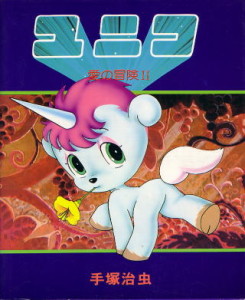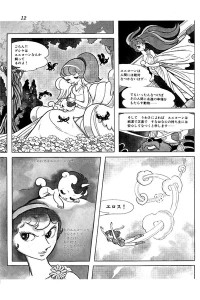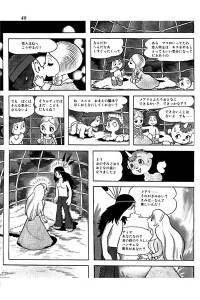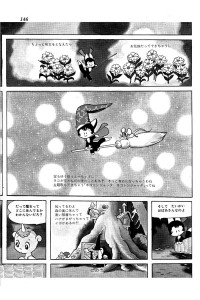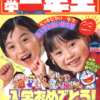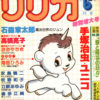Unico (Manga)
Also known as ユニコ (Yuniko)
| English Title: | Unico |
| In English? | Yes |
| Japanese Title: | ユニコ [Yuniko] |
| Type: | Chapter Serial |
| Original run: | November 1976/11 – 1979/03 |
| Published in: | Lyrica |
| Published by: | Sanrio |
| Volumes: | 2 (MT-285 | MT-286) |
Originally serialized in Sanrio’s Lyrica magazine from November 1976 to March 1979, Tezuka’s story about a magic little unicorn, Unico (1976-79), is one of his best known manga series specifically aimed at children.
What it’s about
The story begins in ancient Greece where he has befriended a young mortal girl of unparalleled beauty named Psyche. She is so beautiful that even Venus, the mythological goddess of love, is jealous of her. So, after Venus discovers that Unico is the source of Psyche’s happiness, she plots to do away with him.
When Psyche is pressured into entering Unico into a contest for exceptional pets, Venus makes her move. During the competition, Unico‘s trusting nature is used against him and he is tricked into being kidnapped by Venus’ minions. When Unico is brought before Venus, she summons Zephyrus, the West Wind and commands her to transport Unico through time and space to the Hill of Oblivion. Unable to disobey, Zephyrus does as she’s told and deposits Unico on the hill, leaving him with no memory of his former mistress.
Despite having no memory of his previous life, he quickly makes friends and uses his magic powers to turn their love for him into happiness. From there Unico begins a series of unrelated adventures, each ending with Zephyrus there, one step ahead of Venus’ wrath, to whisk him away to the next location in time and space – often without giving him a chance to say good-bye to his new friends.
Along the way Unico helps a young Indian brave find true love with a white settler’s daughter, becomes embroiled in a “Romeo & Juliette” style story of young lovers caught between two warring kingdoms, meets a little kitten who dreams of being a human girl, rescues a sickly girl from the clutches of an industrial waste-spewing computer tyrant, helps a baby sphinx learn a thing or two about being true to your nature, reforms a thief and helps her find true love, and teaches a little demon the true meaning of friendship.
What you should know
Although written primarily for children, Tezuka was not afraid to tackle tough issues, albeit in a subdued way. Many of Unico‘s adventures deal with complex issues such as interracial love and marriage, animal rights, and environmental issues. As with much of his work, Tezuka is not afraid to shy away from a nice, pat, “Hollywood-style” ending, preferring instead to let his readers, even his very young readers, make their own judgements.
Tezuka also uses Unico (1976-79) to explore his favourite theme of reincarnation, albeit in an interesting way. Each of his adventures being with Unico having his memory wiped, with nothing to tie him to his previous “life”. In this way, Unico is a good example of Tezuka’s Star System, as in each of his lives he is true to his own sweet and gentle nature, and carries none of his “karmic baggage” with him.
It also interesting to note that Unico is somewhat of a “dual citizen”. As Tezuka states in the postscript to the Osamu Tezuka Complete Manga Works edition (MT-286), “Unico was born in the United States, but that doesn’t mean he was created by an American artist” (1983, p. 190). During a visit to Sanrio’s (home of “Hello Kitty”) Los Angeles animation studios, Tezuka was suddenly struck by inspiration. He asked for a piece of paper and quickly sketched out his vision, a little unicorn.
At the time, Sanrio was preparing to release a shojo (young girls) magazine called Lyrica and asked Tezuka to participate. Although a bit hesitant at first, given how long it had been since he’d done a shojo series, he agreed with the vague idea of using an animal as the central character. While flying back to Japan, Tezuka struck upon the name derived from the English word for “unicorn” and Unico was born.
As such, Unico (1976-79) began serialization in Lyrica in November 1976, in full-colour, read in the Western-style, right to left, and with artwork that continued beyond the panels and bled right off the page. Although Unico (1976-79) was successful and matched the “Hello Kitty” house-style Sanrio was looking for, Tezuka was unsatisfied. According to him, “Unico was too perfect, too smooth. It was necessary to have him partner up with characters with stronger personalities” (1983, p. 190). He achieved this by introducing popular characters such as Chao, the kitten and Piro, the baby sphinx.
Following up on the successful run in Lyrica, Unico began appearing in First Grader, a magazine targeted at young students learning to read. Running from April 1980 to January 1984, most of the stories feature Unico living with a young boy named Esuo, and a dragon named Ragon. Although some of the stories are similar in nature to the original series, the stories are shorter and simpler – usually on a few pages long.
Unlike the Lyrica version, First Grader was designed to be read in the traditional right to left Japanese style. However, it has been published in full-colour as well as black and white.
Where you can get it
Luckily, for English-speaking fans, Unico was successfully funded on Kickstarter in 2012, alongside both Atom Cat and Triton of the Sea as part of the “Osamu Tezuka Family Pack” project. It was later published by DMP in 2013 as a full-colour, single-volume edition, in it’s original left-to-right reading format – the product of Tezuka’s early attempts to break into the North American market.
What else you should check out
Check out the link below for chapter summaries and more detailed publication information on Unico (1976-79) serialization in both Lyrica and First Grader.

